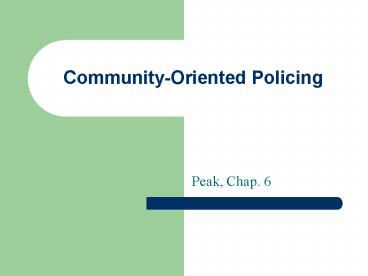Community-Oriented Policing - PowerPoint PPT Presentation
1 / 14
Title: Community-Oriented Policing
1
Community-Oriented Policing
- Peak, Chap. 6
2
Two models of policing
- Professional
- Approach Reactive, incident-based
- Goal Fight crime and disorder
- Objectives (ways to reach goal) Arrest, cite,
coerce - Community-oriented
- Approach Proactive, broadly-based
- Goal Prevent crime and disorder
- Objectives Partner with citizens and community
institutions to identify problems and develop
solutions (problem-solving policing)
3
Community policing
- Broader approach than crime-fighting
- Community defines problems
- Community participates in solutions
- Success measured by citizen satisfaction
- Not mentioned May call for more intrusion, not
less - To do community policing need
- Decentralized authority
- Changes in recruitment and training
- Move away from incident-driven (response)
policing - Different measures of output (results)
4
Extract from Peak Table 6-1 Traditional v.
Community Policing
Traditional (Professional) Community Policing
Police role Solving crimes Broader problem-solving approach
Measure police efficiency Detection and arrest rates(?) Absence of crime and disorder (?)
Highest priorities High-value and violent crimes Whatever problems most disturb the community
What do police deal with? Incidents Citizen problems and concerns
Determinant of police effectiveness Response times Public cooperation
View of service calls Only if there is no real police work to do Vital function and great opportunity
Police professionalism Swift, effective response to serious crime Keeping close to the community
Role of press liaison Keep the heat off operational officers Coordinate an essential channel of communication with the community
5
What Peak doesnt mention
- Are there enough officers to do community
policing? - Officer coverage
- L.A. 7673 officers (1/498 citizens)
- Chicago 11,567 officers (1/248 citizens)
- New York 32,100 officers (1/252 citizens)
- Is community policing potentially more
intrusive? - Broken Windows
- What does the community really want?
- Can officers really provide it?
- Legal obstacles
- Practical obstacles
- Who is best informed about crime citizens or
police?
6
Is community policing / problem-solving more
than rhetoric? Is it a real strategy, with real
applications? If so, is it potentially more
intrusive than the conventional, professional
approach?
Anaheim Officers Kill 1,Wound 1 in Pickup
L.A. Times, 4/6/2005
Two officers that were part of a
problem-solving team that specializes in
communitypolicing shot and killed the driver of
a pickuptruck and wounded his passenger
momentsafter radioing their supervisor that
theyneeded to take care of a problem.
Theshooting took place as the truck was making
aturn at Onondaga and La Palma avenues. There
is no indication that the officers did anything
wrong but further details have not yet been
released.
O.C. Register photo
7
Problem-solvingpolicing
- Crime incidents may only bethe tip of the
iceberg - May only be symptoms of an underlying problem
- To extinguish need to deal with the real
problem - This is not the same as community-oriented
policing - No value judgments as to police role or its
relationship with the community or other agencies - To respond to problems police must be flexible
and willing to experiment - Traditional methods may be ineffective
- Not necessarily a kinder and gentler approach
- May call for more intrusion, not less
8
Step 1 Identify problems
- Look for patterns amongincidents
- Criminal M.O., location, persons,times, events
- Crime analysis
- Crime mapping
- Detailed analysis of incidents and calls for
service - Citizen and business surveys
9
Step 2Tailoring strategies
- Ultimate way of dealing with a problem
- Example street drug sales
- Pay phones no incoming calls
- Cleaning up junk and graffiti
- Screening and evicting tenants who deal drugs
from an apartment house - Gang injunctions
- Surveillance and undercover work
- Issue effectiveness
- Soft responses may not be enough
- Hard responses are expensive and displace
officers
10
Step 3Assessment
- Traditional and non-traditional measures
- Crime trends targeted and other crimes
- Clearance rates
- Citizen complaints
- Fear
- Business profits, truancy, Property values
11
Integrating community policing problem solving
policing
- Provide leadership
- Demonstrate why handling problems is betterthan
handling incidents - Provide incentives to get on board
- Evaluation criteria must change
- Commitment from managers and executives
- Reduce barriers
- Allocate necessary time, resources, manpower
- Train officers in addressing problems
- Overcome resistance
- Give officers leeway in innovation
- Emphasize importance of patrol
?
12
- External relationships collaborate with...
- Other agencies
- Politicians
- Community groups
- Private service providers
- Local businesses
- Broader role for street cop
- Think about problems and develop solutions
- Supposedly more job satisfaction
- Emphasis on crime prevention
- Environmental design (Target Hardening)
13
Evaluations of problem-oriented policing (Peak)
- Tulsa housing complexes with high crime rate and
blatant drug dealing - Volunteer officers placed on walking beats in the
complexes - Officers participated in various
community-building activities - Officers placed on school campuses
- Results Police noted a decline in street drug
sales - Analysis What made the difference?
- Southeast San Diego housing complex - drug and
guns problem - Arrests only provided temporary relief
- Police set up undercover operation
- SWAT served search warrants
- Results Complex became crime-free
- Analysis What made the difference?
14
Evaluation of community policing problem
solving in Chicago
- Ten-year evaluation of largestproject of its
kind in the U.S. - Split-force concept for entire city
- Officer teams in each police beat spend their
time on community projects and problem-solving
efforts - Rapid response units respond to calls for
service - Compstat used to plan police deployment
- Final grades
- Public involvement B
- Agency partnerships A
- Reorganization A
- Problem-solving C































